| Tuesday December 6,
2002 El Calafate, Argentina Yes, we are about to leave
Argentina. We have thoroughly enjoyed our visit here, but
it is time to move on. We take the bus tomorrow morning
to Puerto Natales, Chile. From there we hope to hike in
the Torres Del Paine National Park for a few days, then
we we will be heading north again.
But, I have to back up in time to our last days in
Buenos Aires...
If you are in Buenos Aires, you have to go to a Tango
show. That is where it all began.
We chose to go to the establishment of Seņor Tango. It
isnīt in the best part of town, so included in your
ticket is transport in a minivan. We got picked up by
Georges who told us we had 10 minutes after the show to
locate him and get back on bus 16. This seemed ominous
but I guess it avoids all kinds of nasties like not
finding a taxi home or being robbed.
When we arrived at Seņor Tangoīs big barn of a
theatre, we were escorted to the third balcony and took
seats overlooking the central stage. The show was a
sumptuous production full of costumes, smoke and lights
and music. We were presented with a history of tango,
beginning with two live horses circling the stage and
working up to present day. The numbers were
professionally done and very entertaining. Interspersed
were songs by a woman tango dancer and several numbers by
Seņor Tango himself. The background music was supplied
by a traditional tango band with accordions, strings and
piano. We even had numbers by a second, larger band
consisting of older musicians and more accordions. The
mostly Spanish audience obviously knew and appreciated
the performers as they were given enthusiastic, and well
deserved applause. Before we knew it, the two hour show
was over. It was after midnight, so we joined the rest of
the audience to find our bus ride home.
Our last day in Buenos Aires left us time for another
walking tour. We headed for the Recoleta area. On the way
to this upscale part of the city we walked through the
well treed Plaza Vincente Lopez. Nannys had lined up
their strollers at the entrance to a large play area and
watched while their charges played. Meanwhile their dogs
were safely stowed in a fenced in area near the play area.
This looked like a great idea but my suggestion is that
Buenos Aires institute more stringent Stoop and Scoop
laws. The park was redolent of dog poop.
Our chief destination was the
red brick walled Recoleta Cemetery, final resting place
of the rich and famous in Buenos Aires. The cemetery is
crammed with ornate family crypts, each competing with
the next for the latest in statuary and ornate ironwork
doors. The most famous grave is that of Eva Peron. We
just followed other tourists to find the right spot.
Judging by the fresh flowers on the door and the number
of memorial plaques, she still has a special spot in the
hearts of the locals.
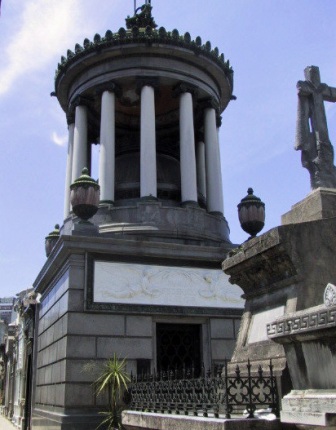
Family Crypt in Recoleta Cemetery |
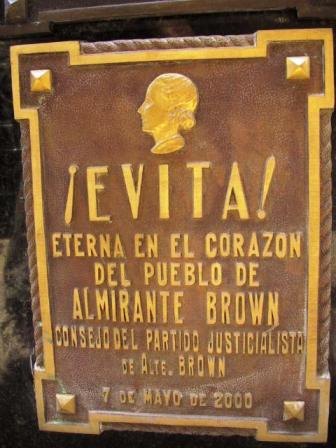
Evita Peron is buried in Recoleta too |
Right next to the cemetery is the historic Iglesia de
Nuestra Seņora Pilar, built in 1732. Besides admiring
the ornate silver altar, we paid AR$1.50 (about 0.75 CAD)
admission to visit the cloisters. This gave us a brief,
interesting history of the church, founded by the Recolta
monks, a branch of the Franciscans. It is claimed that
the history of this church mirrors the colonization of
Argentina.
By the time we left the church we were hungry, so we
headed for a restaurant recommended in the Lonely Planet.
As soon as the waiter realized we were rather deficient
in Spanish, he brought over the manager whose English
wasnīt much better than our Spanish, but who was kindly
determined to help us interpret the menu. In fact, he
brought over another patron, who did speak English, to
make sure there were no mistakes in our order. While we
were eating, another customer sitting nearby struck up a
conversation with us. That has been our experience so far.
We have been treated with nothing but politeness and
friendly interest.
One of the best features of our hostel in Buenos Aires
was the communal sitting and dining area that allowed you
to meet and trade experiences with our fellow travellers.
Our last night we shared a pasta dinner, cooked in the
small kitchen, with an Australian girl, an Italian, a
Columbian and an English couple. It was great fun.
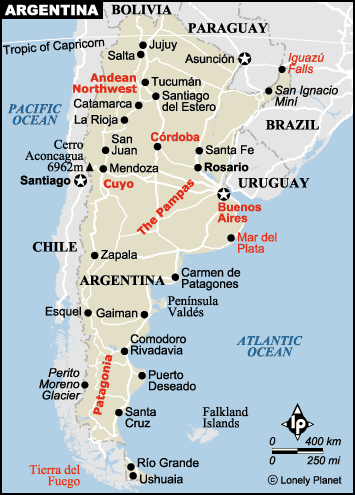
Click
the map above
to see an album of photos of Southern Argentina. Close the window to return to
this page.
|
The next day we flew off to Puerto Madryn, on the
coast more than 1000 Km south of Buenos Aires. We chose
the plane over a 20 hour bus ride over flat, scrubland.
Not very interesting scenery. In fact, most of the
southern part of Argentina is like this. South America
was a lush grassland with lots of dinosaurs until the
Andes reared their heads. The rain from the west was cut
off and the land east of the Andes became desert.
What a shock. We had just acclimatized to the heat of
Buenos Aires, and we were back to cool spring
temperatures of 19 C. It is only going to get cooler as
we travel south, so there is nothing to do but get used
to it!
We went to Puerto Madryn to visit the Peninsula
Valdez, a sanctuary for sea mammals. We were not
disappointed. We signed up for an all day tour the next
day, Thursday, and took off in a minibus early in the
morning. Our first stop was Puerto Piramid, on the Gulfo
Nuevo, to board a whale watching boat. The Southern Right
whales come to this area every year to have their calves
and stay several months until heading off to better
feeding grounds. We were lucky as the day was sunny and
calm, perfect for a boat
ride.
Puerto Piramid has big tides and no central wharf, so
the inhabitants have devised an ingenious method of
launching the tourist boats. About 36 of us were marched
down to the beach where our boat was suspended in a
cradle and attached at the bow by a long handle with a
Massey Ferguson tractor at the other end. We climbed
aboard on a ladder and sat down while the tractor revved
up and pushed the boat over the beach and into the water.
When we were in deep enough water, the boat took over and
backed off the cradle. Quite neatly done.
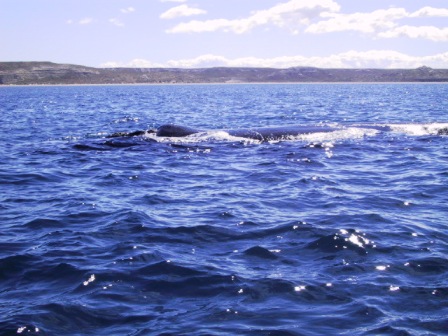 We didnīt have
to go very far until we were in whale territory. There
were two mothers with their calves between us and another
tour boat. After the mothers give birth they stay in the
area for about three or four months without feeding. To
conserve energy they spend most of the time floating
around near the surface, so it easy to see them. We got
close enough to one mother and calf that I thought we
were going to bump into them. They stayed right next to
us, then dove under the boat, giving us a good display of
their huge tails. We managed to get close to them again
before turning back to the shore and giving them a rest. We didnīt have
to go very far until we were in whale territory. There
were two mothers with their calves between us and another
tour boat. After the mothers give birth they stay in the
area for about three or four months without feeding. To
conserve energy they spend most of the time floating
around near the surface, so it easy to see them. We got
close enough to one mother and calf that I thought we
were going to bump into them. They stayed right next to
us, then dove under the boat, giving us a good display of
their huge tails. We managed to get close to them again
before turning back to the shore and giving them a rest.
Back on shore, we loaded into the minivan and drove to
the north end of the peninsula over gravel roads. The area is flat and dry with
no vegetation except scrub bushes. Ranchers keep sheep in
the area but the land cannot support very many of them.
We did manage to see several guanacos, which are small
delicate llamas, a Rhea (ostrich) and a hare the size of
a small dog. We also got to visit with two fat armadillos
who live in a burrow beside our minibus car park. Our
driver told us they are so fat because all the school
children who visit feed them. They were quite tame and
scuttled out to be fed by us too.
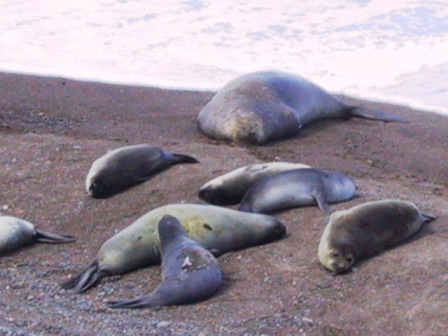 At next two stops were to see
huge elephant seals lounging on the beach. There are 40,000
elephant seals along 90 K of the coast and this was part
of them. Males grow a huge fat, ugly nose as they get
older and compete to control a harem of 30 to 150 females.
There were a few males in the colonies we saw and they
sure were large and very lazy looking. Most of the action
on the beach was from the younger males practising their
fighting pushes and emitting loud burps. In the ocean
just beyond the seals at our first seal stop we had a
bonus sight of about four whales slowly making their way
down the coast. At next two stops were to see
huge elephant seals lounging on the beach. There are 40,000
elephant seals along 90 K of the coast and this was part
of them. Males grow a huge fat, ugly nose as they get
older and compete to control a harem of 30 to 150 females.
There were a few males in the colonies we saw and they
sure were large and very lazy looking. Most of the action
on the beach was from the younger males practising their
fighting pushes and emitting loud burps. In the ocean
just beyond the seals at our first seal stop we had a
bonus sight of about four whales slowly making their way
down the coast.
The next day we stayed around Puerto Madryn to visit
their very interesting Ecocenter. We walked about 3 K
along the beach front to where the center is built on top
of sandstone cliffs. Just outside the center was a
monument to the Welsh colonists who landed here in 1865.
Their first homes were caves dug into the cliff walls.
Remnants of several of the cave dwellings have been
preserved for view. The Welsh must have had a cold and
miserable first few years in that windy spot.
We spent a long time in the Ecocenter enjoying the
displays, viewing videos and reading up on all the sea
animals and birds in the area. We climbed up to a tower
viewing room where comfy sofas invite you to sit and read
one of the many illustrated books on the Peninsula Valdez
and Puerto Madryn.
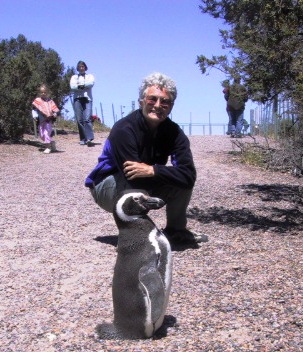
Getting to know a penguin |
Another reason for visiting the Valdes Peninsula is to
see the Megallanic penguin colony at Punta Tombo, south
of Puerto Madryn. There are about
500,000 breeding pairs that visit this colony from
September to April every year, so we took another minibus
tour to see them. I spent last year in New Zealand
raptuing about the six or seven penguins we managed to
see so I was looking forward to seeing more of these cute
little birds. Little did I realize there would be so many
of them. They passed so close to us that we had to watch
that we didn't step on them. We saw them swimming ashore
and hopping and waddling up a steep path to their nests
where their young were calling to their parents with
sharp squawks. They were very intent on their business of
reaching their young and we were very intent on
photographing as many of them as we could.
After leaving the penguins we drove to the small town
of Gaiman, one of the first Welsh colonies established
after the abortive first attempts at cave dwelling in
Puerto Madryn. It was a pleasant little town with a few
of the original Welsh stone cottages, the remnants of an
original railway built by the Welsh and a few pretty
teahouses.
We ended our day with an interesting visit to the
Museo Paleontologico. The area is rich in dinosaur
remains found imbedded in the limestone cliffs. We were
told that this now almost desert area was once a tropical
paradise until shifting plates of the earth pushed up the
Andes. The high mountains blocked the rains coming from
the west and the lush plains were transformed to deserts.
That is why the whole of Argentina south of Buenos Aires
is so desolate and dry.
Our next stop was El Calafate. Once again we opted for
an expensive flight to avoid a boring 20 hour bus ride.
It was worth it. At least we got our first glimpse of the
Andes as we approached El Calafate.
The main reason to visit El Calafate, on Lago
Argentino, is to see the Glacier Perito Moreno. We took
an all day bus excursion as it is 87 K around the lake
from town. We had a guide with a sense of humour,
sometimes a little black as he bemoaned the effect of
thousands of tourists on a sleepy little village. He said
people who choose to live in this otherwise godforsaken
part of the world are rather eccentric and he was no
different. The population of Patagonia averages 0.8 per
sq K. It even takes 4 acres to support one sheep. That is
because it is so barren and windswept. South America
extends farther towards the South Pole than any other
continent, so there is nothing to stop the winds that
circle the earth.
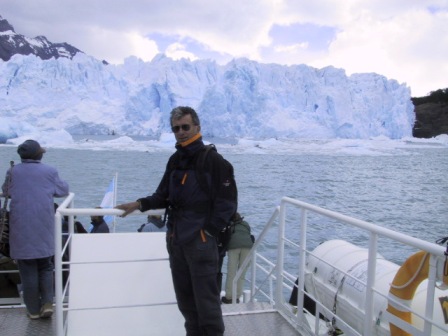
First look at Perito Moreno Glacier |
The Glacier did not
disappoint. It is named after Francesco (Perito) Moreno,
who is considered the father of the National Parks in
Argentina. He was one of the first non-native persons to
explore Patagonia. For his efforts, he was awarded a
large tract of land in the area which he promptly gave
back to Argentina with the proviso it remained unchanged.
The Glacier, which has a front of 5 K, ends in a sheer
blue snow and ice cliff, 60 M high in places, that
descends into Lago Argentino. The continual snows far up
in the mountains force the glacier forward at a rate of 2
M per day. As soon as the warm spring sun hits the
glacier, it begins to calve. This means that there are
loud booms and rifle cracks as huge sections of the
glacier split from the front and crash into the water,
sending icebergs sailing down lake. We spent a lot of
time admiring the glacier from the cliffs facing the
glacier and from the extensive boardwalks and platforms
built to accommodate all the tourists. We tried to guess
when the next and biggest crash would occur. In the
afternoon we boarded a small boat to sail parallel to the
glacier and get an even better view. We heard a loud boom
and saw a huge section of the glacier fall away at the
far end. It looked as if this had weakened adjoining
sections so the boat speeded up to bring us closer. Sure
enough, more of the glacier gave way. One section crashed
into the water disturbing a submerged iceberg that
breached into the air like a frozen whale. We all madly
snapped pictures.
The next morning we headed off on the bus to El
Chalten, a center for hiking and mountain climbing. It is
only 225 K from El Calafate, but 195 K is gravel. The bus
can go no faster that 40 Km/hr over this section so it
takes 4 1/2 hours to get there. There is nothing in
between except a few lonely ranches (estancias). At least
the scenery became more interesting as we approached El
Chalten. We passed by high sedimentary cliffs and had
good views of Glacier Viedma as it ended in the Lago
Viedma. We had to stop twice along the road. Once to let
a family of Andean geese waddle across to a pond on the
other side and another time to scare a small herd of
Rheas into the fields.
El Chalten is a motley collection of hostels and
restaurants servicing the growing number of tourists
attracted to the mountains rising behind the town. There
are no paved roads in the village and consequently the
fierce Patagonian winds cover everything with dust. It
doesnīt sound very appealing, but if you are a hiker or
climber, it is the perfect spot. We managed to follow
just a few of the multiple trails available.

El Chalten Waterfall |

Lago Del Torre |
The first day we
had an easy walk to a pleasant waterfall and then
Wednesday morning we set out for Lago Del Torre, named
for a craggy peak next to it. We started out with our
rain jackets on, but as soon as we climbed away from
windswept village, the coats came off. The clouds were
hanging over the mountains so our view was partially
obscured but it was a nice walk. It took us 2 1/2 hours
to reach the lake, by which time our jackets were back on
to protect us from the light drizzle emanating from those
clouds. The small turquoise lake was nestled in the
bottom of a bowl, 2/3 of which were 50 M high gravel
moraine hills and the other 1/3 was the terminus of the
Glacier Del Torre. We
climbed up the side of the moraine to follow a path along
the top edge, but the fierce winds blowing across the
lake from the glacier forced us to find shelter on the
protected side of the moraine hills. We found a nice spot
with a view to have or picnic lunch, then went to explore
a campground in a grove of beech trees to the left of the
lake. This is a base camp for climbers and for those on
guided expeditions on the glacier. A couple we met in the
hostel were on the glacier hike that day. From town and
back again it was a 14 hour day with only a half hour
lunch break on the glacier. I would love to do the trip,
but I would stay in the campsite before and after the
glacier walk. Several companies offer tents, sleeping
bags and meals for a glacier trip.

Fitz Roy peak |
The next day dawned clear and blue, which is unusual
for El Chalten, the perfect day to see all the peaks. I
had been hoping that the cold I was developing would just
go away, but it was not to be. I was going through too
much Kleenex to go on another hike. I just stayed nice
and quiet all day, reading a book while Ray had a great
day hiking up to see Fitz Roy Peak, the most famous and
difficult climbing peak in the area. It is only 3441 M
high but the sheer rock sides make it a technical
challenge. Ray walked up first to the base camp for
climbers, at 800 M. He had
great clear views of Fitz Roy before the afternoon clouds
started accumulating again. From the camp he hiked up
another 400 M to the Lago de Los Tres, a small tarn at
the base of the mountains, named for three French
climbers who were among the first to successfully ascend
Fitz Roy. The lake was frozen over, the ground was snow
covered and ice pellets were falling, so he didnīt
linger there, but considered himself lucky to have seen
as much as he did.
That same day, we took the 6 PM bus back to El
Calafate. It is daylight until almost 10 PM at this
latitude, so we were able to enjoy the landscape again.
About 8 PM, 75 K out of El Chalten, our bus was flagged
down by a couple on bicycles. They had just made a turn
that brought them right into the wind. They would be
lucky to make 10 Km/hr over that loose gravel. They were
exhausted and realized they were not going to make El
Chalten by dark. The bus driver told them there was a
minibus coming along in about 45 minutes that could take
them into El Chalten, but not their bicycles. Their
bicycles would have to be left next to the road to be
picked up by the incoming bus the next morning. They had
no choice but to wait as there was virtually no other
traffic on the road and no place to stay. If you want to
bicycle to El Chalten, you have to have tents and be self
sufficient or you put your bike on the bus for that
section.
We are back in El Calafate for the day, doing chores,
but tomorrow we are bussing south to Puerto Natales, in
Chile. I am recuperating, so by the time we are ready to
hike in Torre Del Paine, I should be fine.
I imagine everyone is getting ready for Christmas back
home. It hasnīt hit us yet. There are some decorations
around, but nothing like the overkill in North America!
We donīt know where we will be on the 25th, but
wherever, it will be an adventure.
So, goodbye Argentina, we did love you, and hello
Chile!
|

